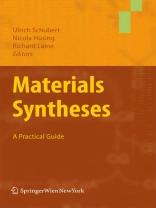Materials syntheses are generally more complex than syntheses of inorganic or organic compounds, and specific characterization methods play a more important role. Materials synthesis protocols often suffer from unclarities, irreproducibility, lack in detail and lack in standards. The need to change this situation is the main motivation for this book. A number of detailed protocols has been collected, ranging from organic polymers to carbonaceous and ceramic materials, from gels to porous and layered materials and from powders and nanoparticles to films. Preparation methods include intercalation and flux methods, sol-gel processing, templating methods for porous materials, sonochemistry or spray pyrolysis.
Each contribution provides detailed and unambiguous description of the hardware, specific characteristics of the procedure, scope of applicability as well as methods that unequivocally identify and characterize the material and allow checking whether the synthesis was successful.
İçerik tablosu
Controlling Size and Morphology of Zeolite L.- Zeolite A and ZK-4.- Mesostructured Silica Thin Films.- Organically Modified Monolithic Silica Aerogels.- Porous Silica Gel by Acid Leaching of Metakaolin.- Zirconia-Pillared Clays.- Montmorillonites with Mixed Aluminum-Lanthanide Oxide Pillars.- Birnessite-type Manganese Oxide by Redox Precipitation.- Templated Carbon from Pyrolysis of Pyrene in Pillared Clay Matrices.- Fiberous Carbon from Sepiolite Clay and Propylene.- Aerosol Spray Synthesis of Porous Molybdenum Sulfide Powder.- Sonochemically Prepared Molybdenum Sulfide.- Doped Manganites.- Lithium Manganese Oxide Prepared by Flux Methods.- Nanoscale Magnesium Oxide.- Nanostructured Pt-doped Tin Oxide Films.- Organically Functionalized Silica Nanoparticles.- Copper Nanoparticles in Silica.- Copper Nanocrystals.- Assembly of TOPO-Capped Silver Nanoparticles to Multilayered Films.- Colloidal Dispersion of Gold Nanoparticles.- One-dimensional Nanorods and Nanowires.- Monolithic Tin-doped Silica Glass.- Octaphenyloctasilsesquioxane and Polyphenylsilsesquioxane for Nanocomposites.- Polysilsesquicarbodiimide Xerogels.- Polyaniline — A Conducting Polymer.- Allyl- and Hydroxytelechelic Poly(isobutylenes).- Symmetrically and Unsymmetrically Substituted Phthalocyanines.












